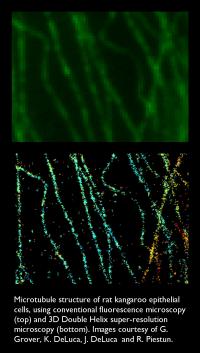Boulder’s Double Helix has entered into a unique option agreement with the University of Colorado, through which Double Helix can develop an innovative technique for 3D super-resolution imaging.
 This shows microtubule structure of rat kangaroo epithelial cells with conventional fluorescence microscopy, top, and 3-D Double Helix super-resolution microscopy
This shows microtubule structure of rat kangaroo epithelial cells with conventional fluorescence microscopy, top, and 3-D Double Helix super-resolution microscopy
CU-Boulder Professor Rafael Piestun of the electrical and computer engineering department has developed this technique. Super-resolution techniques are formulated in such a way, wherein the resolution of an imaging system will exceed the limitations created by the diffraction of light. The advanced microscopes and other optical instruments are developed based on the diffraction of light. The Double Helix optical technology integratesthe 3D optics with an exceptional signal post-processing technique that creates quality enhancements in image processing.
According to the director of Computational Optical Sensing and Imaging, Piestun, with the optical technology, multifunctional 3D super-resolution imaging solutions can be offered to multiple laboratories globally and in the U.S that are related to biophysics, cellular, and molecular biology. The Double Helix technology platform forms the basis for the implementation of several industrial, scientific, and consumer applications such as computational digital photography, microscopy, and metrology.
Double Helix founding partner Leslie Kimerling said that this revolutionary technology will initially be popular among the microscopy market and then in the markets of metrology and digital optics, where the Boulder entrepreneurial community has a stronghold.
One of the licensing managers at the CU Technology Transfer Office, Ted Weverka said that with its economical and advanced technology, Double Helix will have a successful progress.